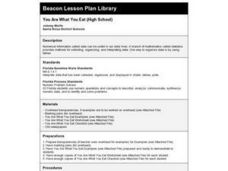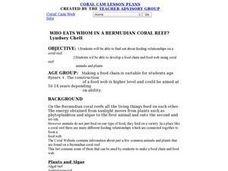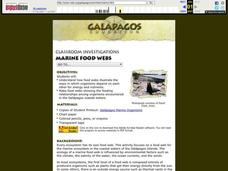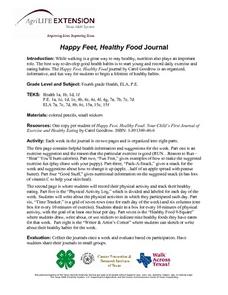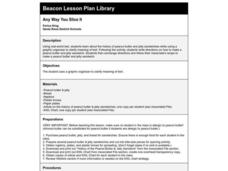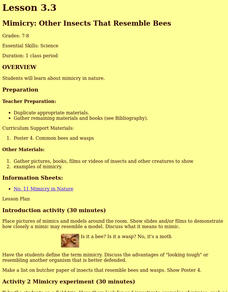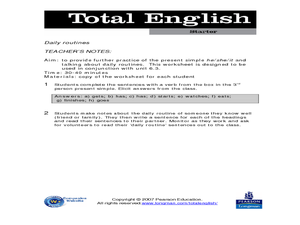Curated OER
Comparing Apples and Oranges
Fifth graders, in groups, examine different types of apples and how they are different. They also taste the differences of each apple. They use this lesson to explore how to make observations.
Curated OER
Supporting Ideas
In this supporting ideas worksheet, students read the sentences and then select the word to complete the supporting ideas in the 6 examples.
Curated OER
Biotechnology, GMOs and Food
Twelfth graders explore controversy around genetically modified foods, identify source of controversy, and role play town hall meeting on genetically modified foods, to examine viewpoints and arguments for and against genetic modification.
Curated OER
Identifying trophic levels and the skeletal system through Owl Pellets
Young scholars identify a food chain sequence. They compare, identify, and record the rodent skeletal parts to a rodent skeletal diagram. Students construct a rodent skeleton from the skeletal parts found in the pellet. They are given...
Curated OER
You Are What You Eat (High School)
Students evaluate data from a statistical chart or graph which they find in a newspaper or magazine.
Curated OER
Good Enough To Eat
Young scholars are introduced to the five food groups. In groups, they place different foods into the correct section of the Food Pyramid. Using different types of technology, they create one page of a class ABC book sharing what they...
Curated OER
Teeth and Eating
Students explore animal diets and teeth. In this animal science lesson, students view photos of animals and their teeth. Students identify the type of diet the animal has based on the teeth. Students are introduced to the terms...
Curated OER
Who Eats Whom in a Bermudian Coral Reef?
Students will be able to find out about feeding relationships on a coral reef. They then will be able to develop a food chain and food web using coral reef animals and plants using the Coral Website.
Curated OER
Food Chains
Students create their own food chains on Kidspiration starting from the energy of the sun and what it creates. In this food chains lesson plan, students learn about how insects eat plants and so on.
Curated OER
Marine Food Webs
Students examine how food webs illustrate the ways in which organisms depend on each other for energy and nutrients, and make food webs showing the feeding relationships among organisms encountered in the Gal??pagos coastal waters.
Curated OER
Recyclers to the Rescue
Fifth graders examine the concept of the food chain and define producer, consumer, herbivore, carnivore, and omnivore. They draw a food chain for a mouse and discuss the different organisms involved in the chain, and conduct an...
Curated OER
Food Chains
Learners investigate the food chain. In this ecology lesson plan, students define producers and consumers. Learners use organism cards to demonstrate how the food chain works.
Curated OER
Food Webs
Students create a bulletin board display illustrating food chains they make from a list of ocean organisms. Students also play a game showing what happens when one of the organisms is removed from the food chain and how they are all...
Curated OER
Happy Feet, Healthy Food Journal
Fourth graders record their physical activities and eating habits in a journal. They place their answers in the workbook, Happy Feet, Healthy Food. They sketch and write about their weekly healthy habits.
Curated OER
Feed Your Cells
Students examine and research the human digestive system and what happens to the food we eat. They read the article, The Passage of Food, participate in an experiment with crackers, and write a paragraph summarizing the function of the...
Curated OER
Edible Plants
Young scholars determine what part of a plant they are eating when they eat different fruits and vegetables.
Curated OER
Secrets of the Ocean Realm - Survival in the Sea
Students determine the sequential links in a marine food chain and identify the roles that various organisms play in this chain. Students develop charts as visual aids for illustrating marine food chains.
Curated OER
Animal Masks
Students design and make animal masks. In this research and application lesson plan, students use a computer to research what a panther eats, select an animal mask they want to make and then use the materials provided to create...
Curated OER
Test Your Grammar Skills: Conjugate a Verb Today! (positive – example)
In this grammar skills worksheet, students will read examples of how to conjugate verbs. Graphic organizers show how to conjugate a verb in the present, past, and future tenses.
Curated OER
Any Way You Slice It
Young scholars read an article on the history of the peanut butter and jelly sandwich and transfer the information onto a graphic organizer. They write instructions on how to make a sandwich and switch with a partner. They make and eat...
Curated OER
Mimicry: Other Insects That Resemble Bees
Learners design a conceptual experiment to test whether mimics actually benefit from the fact they resemble other organisms or objects. They define the term mimicry. They focus on insects that resemble bees and wasps.
Curated OER
Total English Starter: Daily Routines
In this daily routines grammar worksheet, learners complete 8 sentences as they fill in the blanks with a verb from the word bank in the correct form. Students then record information regarding daily routines on the graphic organizer.
Curated OER
CSI Clamshell Investigation
Pupils explore and explain how moon snails eat and where the holes in clamshells come from and then draw conclusion from the data collected. They incorporate math and graphing skills to determine if there is a relationship to a clam's...
Curated OER
Oh That Gross Digestive System!
Young scholars get an understanding of the main components of the digestive system and how the system takes the food we eat and converts it into energy.




